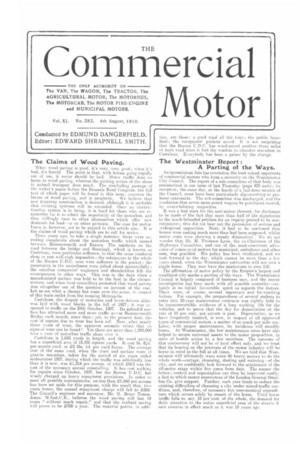The Claims of Wood Paving.
Page 1

If you've noticed an error in this article please click here to report it so we can fix it.
When wood paving is good, it's very, very good ; when it's bad, it's horrid. The point is that, with horses going rapidly out of use, it never should be bad. Motor traffic does vu harm to wood paving, whereas the picking action of the shoes in animal transport does much. The concluding passage of the writer's paper before the Brussels Road Congress, the full text of which paper will he found in this issue, concerns the future of wood paving, and is prophetic. We believe that new tramway construction is doomed, although it. is probable that existing systems will be extended. Once an electrictraction system is in being, it is hard for those who are responsible for it to admit the superiority of the motorbus, and they willingly turn to other alternatives which offer new demands for ioad—or on other pretexts. The case for motorbuses is, however, not to be argued in this article also. It is the claims of wood paving which are to call for notice.
Three years ago, to take a single instance, there were unending complaints about the motorbus traffic which passed between Hammersmith and Barnes. The residents on the road between the bridge and Ranelagh, which is known as Castelnau, were particular sufferers, in that the noise rendered sleep or rest well-nigh impossible: the ratepayers in the whele of the Barnes U.D.C. area. were sufferers in the pocket ; the passengers in the motorbuses were jolted about unmercifully ; the omnibus companies' engineers and shareholders felt the cousequences in other ways. This was in the days when a macadamized surface was held to be the best in the eircurnstancos, and when local councillors protested that wood paving was altogether out of the question on account of the cost. Let us see what a change has come over the scene, in respect. of this main outlet from the teeming Metropolis. Castelna.u, the despair of motorists and horse-drivers alike. was laid with wood blocks in the fall of 1907; it was reopened to traffic on the 24th October, 1907. Its splendid surface has attracted more and more traffic across Hammersmith Bridge each month, since their; yet, to the present date, the cost of repairs due to wear has been nil. Now, after nearly three "ears of wear, the apparent anomaly exists that no signs of wear can be found ! Yet there are more than 1.000,000 tons a year of motorbus traffic alone over it.
Castelnau is 1,650 yards iii length. and the wood paving has a superficial area of 19,550 square yards. It cost 9s. Nd. per square yard, or £5 16s. id. per yard linear. The average cost of the same road, when the crust and surface were of granite macadam, taken for the period of six years ended midsummer 1907. during which the traffic was admittedly less than it is now. was £1,314 per annum, of which £913 was the cost of the necessary annual remetalling. It has cost nothing for repairs since October, 1907, but the Barnes U.D.C. has wisely charged up heavy repayment provisions. .1n order to meet all possible contingencies, no less than £1,660 per annum has been set aside for this purpose, with the result that, two years hence, the annual repayment charge will fall to £560. The Council's engineer and surveyor, Mr. G. Bruce Tomes. Assoc. M.Inst.C.E., believes the wood paving will last 10 years " without much repair." arid that the realized saving will prove to he £700 a year. The material points. in addi
tion. are these: a good road all the time ; the public benefited ; the ratepayers' pockets saved. It is not surprising that the Barnes U.D.C. has wood-paved another three miles at main road since it had the wisdom to abandon macadam in Castelnau. Everybody has been a gainer by the change,




















